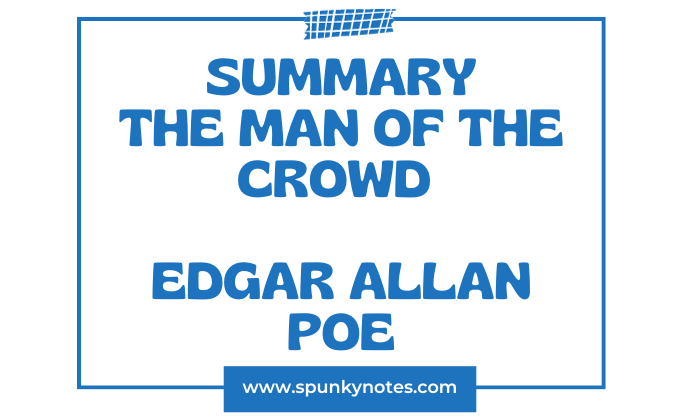
Q. Write down the summary of The Man of the Crowd, written by Edgar Allan Poe.
The Man of the Crowd Summary
Introduction
“The Man of the Crowd” is a short story by Edgar Allan Poe, first published in 1840. This short story appeared in a periodical rather than in a volume initially.
It was published in “Atkinson’s Casket,” a famous 19th-century American magazine. Later, the story was included in various collections of Poe’s works. It is a tale of curiosity and the complexities of human nature, set in a bustling urban landscape.
Story Overview
In “The Man of the Crowd,” a man sitting in a London coffee shop watches people pass by. He sees many types of people and thinks about who they are. An old, strange-looking man catches his attention in the crowd. This man looks nervous and different.
The narrator decides to follow him through the city streets. This chase goes on all night, taking him through various neighborhoods. The story shows his journey, filled with curiosity and mystery, as he tries to understand this mysterious man.
Encounter with the Mysterious Man
In “The Man of the Crowd,” the narrator spots an old man who looks very strange in the crowd. This man stands out because he seems anxious. His face shows many emotions, but mostly fear and worry.
The narrator is very interested in this man because he is so different from everyone else. It makes him want to know more about the man’s story. He decides to follow him to see where he goes and what he does.
The Pursuit Begins
In Edgar Allan Poe’s story, the narrator decides to follow the strange older man after seeing him. This decision starts a long chase through the streets of London. The narrator is curious and wants to discover why this man is so different.
As he follows, the older man moves quickly and seems to have no clear destination. He walks through busy streets, crowded markets, and quiet alleys. The man’s behavior is odd; he sometimes walks fast, slows down, looks around, and even returns the way he came.
The narrator keeps a close eye on him, making sure not to lose sight of him. This chase goes on for hours, taking them to different parts of the city. The narrator is determined to uncover the mystery behind this mysterious man.
Observations During the Pursuit
In “The Man of the Crowd,” as the narrator follows the old man, he sees many sides of London. The chase takes them through busy streets where many people shop and work.
They pass through rich areas with fancy shops and then into poor neighborhoods where the narrow streets and the houses look old and tired.
The narrator notices that the older man acts differently in each place. He seems excited and moves fast in busy areas, but in quiet streets, he slows down and looks worried.
The older man also watches people a lot, especially in crowded places. He seems to be looking for something or someone, but he never stops or talks to anyone.
This is what perplexes the narrator. He wonders why the older man is walking without a clear goal and what he is searching for in the crowd. It makes him even more curious about the mysterious man.
Realization and Reflection
During his long pursuit in “The Man of the Crowd,” the narrator starts to understand something about the old man. He realizes the older man might need a specific place to go.
The older man needs to be around people all the time. He goes into crowded places but never really joins in. He is always just watching and moving through. This understanding leads the narrator to a profound insight, captured in Poe’s words:
This old man,” I said at length, “is the type and the genius of deep crime. He refuses to be alone. He is the man of the crowd.
This statement reflects the narrator’s belief that the older man represents more than just an individual; he symbolizes a deeper, possibly darker aspect of humanity.
His relentless pursuit of refusing to be alone suggests that the man might embody the essence of some profound wrongdoing or secret.
The story ends without a clear resolution. The narrator stops following the older man, accepting that some individuals, like the man of the crowd, cannot be understood or categorized.
The story concludes with a sense of mystery and the unsettling idea that some people are impenetrable and defy understanding.
Analysis of The Man of the Crowd
Human Complexity and Mystery
Poe’s story highlights the complexity of human nature. The older man, who is the focus of the narrator’s attention, represents people’s enigmatic and often impenetrable nature.
It is difficult to understand who the man is and why he behaves the way he does, symbolizing how difficult it is to get to know someone.
Theme of Isolation
Despite being set in a crowded city, the story highlights a sense of isolation. It is seen through the narrator’s thoughts and silent pursuit of the older man.
It suggests that individuals can feel deeply alone and disconnected even in a bustling society.
Observation vs. Participation
The narrator is an observer, not a participant. His choice to watch from a distance rather than interact shows his tendency to observe life without engaging. It reflects on societal behaviors, where people often choose to be bystanders rather than active participants.
Urban Setting
London acts like a character in the story. The urban setting is key to the theme, showing the city’s anonymity and closeness. The crowded streets provide a perfect backdrop for exploring loneliness in company.
Psychological Exploration
Poe is known for his psychological narratives; this story is no exception. The narrator’s obsessive following of the man showcases psychological depth, exploring curiosity, obsession, and the human desire to understand the unknown.
Ambiguity and Open-Endedness
The story is intentionally ambiguous and needs a clear conclusion. The story needs a clear ending, making us think about its meaning. It is something Edgar Allan Poe often does in his stories. He makes us wonder about people and how society works.
Impact of the Epigraph
The French epigraph, translating to “This great misfortune of not being able to be alone,” plays a significant role. It sets the thematic stage of the story, emphasizing the inner conflict between seeking solitude and being part of society.
In summary, “The Man of the Crowd” is less about external action and more about internal reflection. It challenges readers to ponder the complexities of human nature, the paradox of solitude in society, and our roles as observers in the world.

